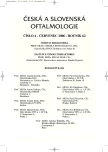-
Medical journals
- Career
The Slovak Study of the Travoprost Treatment Efficacy
Authors: M. Potocký
Authors‘ workplace: Súkromná očná klinika Veni-Vidi, s. r. o., Obchodná 44-46, Bratislava vedúci pracoviska doc. MUDr. Marián Potocký, Ph. D.
Published in: Čes. a slov. Oftal., 62, 2006, No. 4, p. 263-269
Overview
Purpose:
To confirm the efficacy of the travoprost treatment during twelve months follow-up in groups of patients: without previous treatment, with different previous anti-glaucomatous treatment, and with different stage of compensation.Patients and methods:
The study evaluates the lowering of the intraocular pressure (IOP) in 143 patients (286 eyes). The intraocular pressure was measured by means of aplanation tonometry, before the treatment started, and after 1, 3, 9, and 12 months at 8–9 o’clock a.m. Patients were divided into eight groups according to the previous mono therapy or combined therapy substituted by travoprost mono therapy or its combination. A special group constituted patients with travoprost as a primary treatment.Results:
In the first group, with latanoprost substituted by travoprost, the intraocular pressure decreased by 7 % (p ≤ 0.0001). In the second group of patients, with travoprost as the primary glaucoma treatment, the intraocular pressure decreased by 22 % (p ≤ 0.0001). In the third group, the beta-blocker was substituted by travoprost, with 22 % (p ≤ 0.0001) decrease of the IOP. In the fourth group, the combined therapy of beta-blocker with latanoprost was substituted by combination of beta-blocker and travoprost and the decrease by 8 % (p ≤ 0.0001) was significant during the first nine months of the follow-up period, later on, the decrease was not significant. The substitution of the combination of beta-blocker and latanoprost by travoprost mono therapy in the fifth group created only no significant lowering of the IOP during the whole follow-up period. If the travoprost mono therapy substituted the combination of beta-blocker with local carboanhydrase inhibitor in the sixth group, the IOP decreased by 20 % (p ≤ 0.001). In the seventh group, the combination of the local carboanhydrase inhibitor and latanoprost was substituted by combination of the local carboanhydrase inhibitor with travoprost, the IOP lowering was not significant. On the other hand, in the eighth group, different combinations of antiglaucomatics were substituted by travoprost, and this caused significant lowering of IOP by 20 % (p ≤ 0.0001). In all cases, the lowest decrease of IOP during the whole follow-up period in the eye with worse compensation is given.Conclusion:
Travoprost lowered effectively the intraocular pressure in 6 out of 8 groups of patients, e.g. in 129 patients (out of 143 patients), the range of lowering was 7–28 % bellow the initial level, the follow up period was 12 months. The decrease of the IOP was stable. The drug was well tolerated.Key words:
glaucoma, travoprost, prostaglandines, combinations of antiglaucomatic drugs
Labels
Ophthalmology
Article was published inCzech and Slovak Ophthalmology

2006 Issue 4-
All articles in this issue
- The Effect of Glycine with Timoptol on the Rabbit IOP Physiological Values
- TINU Syndrome
- The Slovak Study of the Travoprost Treatment Efficacy
- Antiglaucomatic Drugs – Content of Preservatives and the Patient’s Compliance
- Surgical Treatment of Submacular Hemorrhage Combined with Tissue Plasminogen Activator (a Case Report)
- Infliximab in the Treatment of Wegener’s Granulomatosis: Case Report
- Czech and Slovak Ophthalmology
- Journal archive
- Current issue
- Online only
- About the journal
Most read in this issue- TINU Syndrome
- Antiglaucomatic Drugs – Content of Preservatives and the Patient’s Compliance
- Surgical Treatment of Submacular Hemorrhage Combined with Tissue Plasminogen Activator (a Case Report)
- Infliximab in the Treatment of Wegener’s Granulomatosis: Case Report
Login#ADS_BOTTOM_SCRIPTS#Forgotten passwordEnter the email address that you registered with. We will send you instructions on how to set a new password.
- Career

